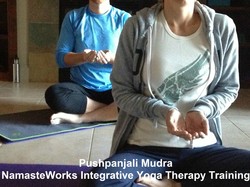 During the past weeks of class, we have been practicing the Pushpanjali Mudra during our opening time of breathing and centering. Pushpanjali means an offering of flowers. I picked this mudra because it is known for reducing stress and the lowering of blood pressure and aides in "releasing attachments at all levels of being" * while cultivating generosity. Pushpanjali is for "cultivating non-grasping - Aparigraha."* The Yamas are the first of 8 Limbs of Yoga. See my blog from September 2013 for more on the Limbs of Yoga: http://www.yogawithgrace.net/pams-blog/8-limbs-of-yoga . The Yamas are a list of ways we interact with others. Aparigraha (a-par-I-gra-ha) is the fifth Yama and is translated to mean non-grasping, non-coveting or non-possessing. The idea is to look at our lives and see where we hold onto stuff or yearn for stuff others have. "Stuff" is either physical things or more spiritual, internal stuff. As we look around at the things we posses we ask the question, do I really need it? What does it really do for me? Then we look inside to find what we might be holding onto, memories, hurts, titles, and more. These things we hold onto block us from really moving onto compassion and generosity. Practicing Aparigraha actually brings us to the point of interacting better with others. For example, if we covet something a friend has or does it blocks us from truly getting close to her. Practicing aparigraha, we would celebrate that she has a great job, blonde hair, or can crochet. When we aparigraha with our physical stuff, we find ourselves more able to let go off it and share it with others who do not have. When we practice aparigraha we celebrate that we can do the Tree Pose even when it looks a little different then the person next to us. The article "7 Ways to Practice Aparigraha" by Irene Petryszak is a great and easy read on how to practice Aparigraha. Irene lists and explains the following steps: Let It Go, Breathe, Practice Self-Care, Be Positive, Forgive, Practice, and Be Generous. The post "Aparigraha" on www.earthdancehealingarts.com is also focused on the practical aspects of Aparigraha. Jen explores how we can apply Aparigraha to many aspects of our lives including our yoga practice and our personal view of ourselves. Jen also lists some important questions to ask ourselves as we continue to practice Aparigraha. Give the article and the blog a read and let me know if you found them helpful. If you click on the green highlighted titles, the article and the blog with come up on a separate screen. Feel free to respond to this blog about your practice of Aparigraha. *from Mudras For Healing and Transformation by Josepha and Lilian Le Page Article on Pushpanjali: http://namasteworksyoga.com/pushpanjali-mudra-appreciate-life-just-as-it-is
0 Comments
 elrincondelsadhu.blogspot.com This week we will be learning the Shankha Mudra or Shell. Shankha means counch shell. Shankha Mudra deals with safety, calming effect and clarity of speech. I also found a reference that said the Shankah Mudra is good for allergies! This is great for our present time! I have attached a printout of the Shankh and Padma mudras. Click on "download file" below!
 This week in yoga week used the Lotus Flower Mudra or Padma Mudra. With all that we have experienced this week, the peace and compassion of this mudra seemed important. We also did the lotus breath during our initial time of breathing and centering. Lotus breathing: Rest the backs of your hands on your thighs with palms up. Inhale and as you exhale, slowly bring the tips of your fingers together to form a bud. As you inhale, slowly open the bud into a flower. Repeat the opening and closing of your lotus flowers as you are comfortable. End your breathing by holding the Padma Mudra. |
AuthorI enjoy yoga as it brings peace to my life. Teaching yoga has brought joy to my life and given me a chance to encourage others in learning yoga. Archives
July 2020
Categories
All
|
||||||
 RSS Feed
RSS Feed
